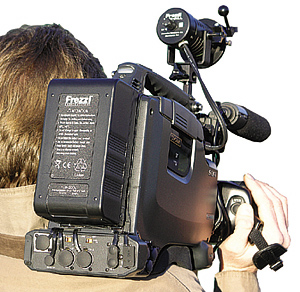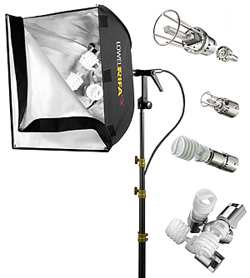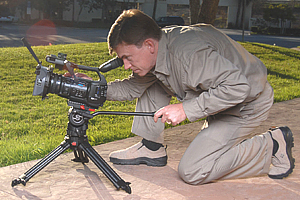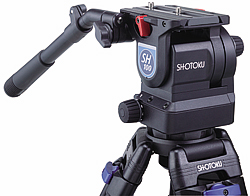Doing More With Less
SEATTLE As somebody who spent about seven years shooting TV news during some of television's halcyon times, this writer still never remembers anybody suggesting he start doing less with more.
But now that the TV business has been slammed with the worldwide economic crisis on top of an already shaky media business climate, news photogs are being pushed even harder to do more with less. Equipment vendors who supply peripheral gear for these electronic news gatherers have offered up suggestions on how their equipment can help them become even more efficient.
BATTERIES
Power is a good place to start, because without power for the cameras and, in darker locations, portable lights, there are no TV images.
In spite of tighter lithium-ion battery air transport restrictions, Frezzi Energy Systems President James Crawford reported he's getting firm orders for the company's new 200 Wh lithium-ion batteries.

An FLB-200 lithium ion battery powers a shoulder-mounted professional camera rig along with a Frezzi Mini-fill On Camera light. "I think we're seeing a return to the one-man-band in TV news, and we have demand for the 200s from people shooting news in big cities," he said. "They have power-hungry HD camcorders and lights to run, and they need a battery to handle that."
Such a 200 Wh battery can deliver eight hours of runtime with a 25-watt camera load.
Frezzi also offers lower Wh lithium ion batteries to stay under air transport restrictions.
PAG engineered its L95E lithium ion battery pack to provide a lightweight power source for camera and light combinations drawing up to 35 watts. It features an LED capacity indicator it calls the Power & Time Circle. It uses five LEDs to display charge status in terms of percentage.
"It comes with a V-mount, which is what most of the Japanese cameras now provide," said Steve Manios, president of Ste-Man, which markets PAG products in the U.S. "The small size of the L95E allows a camera operator to put two in the camera bag and operate most news camera and light packages for the whole day."
The theory at Anton/Bauer is that a news cameraman can be most efficient if he has exactly the right battery every time he goes out on assignment. "If you're going to be climbing mountains all day, then I've got the Dionic 90s, the smallest, lightest and most powerful battery, inch for inch, pound for pound," said Paul Dudeck, Anton/Bauer head of North American sales.
For a shoot that is going to take the news photog away from a recharging station for a period of time, or who is going to have a long, uninterrupted run of the camera, Dudeck suggests the lithium-ion Dionic 160. For someone traveling by airline who needs power but not the restrictions on lithium ion cells, he pointed to their Hytron 140, which uses nickel metal hydride cells that are not subject to air transport regulations.
Higher power consumption from new HD camcorders sent IDX to the drawing boards to develop a pair of Endura batteries: the E-7, a lightweight 68 Wh lithium ion battery pack, and the higher capacity E-10 93 Wh lithium ion battery pack. "Our batteries can handle a high power consumption load while remaining lightweight," said Tony Iwamoto, IDX executive vice president for sales and marketing.
IDX's V-mount battery packs are available in a power-link version that allows them to be stacked, piggyback on a camcorder to add together their capacity, or in a less expensive non power-link version. Iwamoto said IDX will add a new model to the Endura line at the 2009 NAB Show.
LIGHTS
So that a news shooter doesn't have to carry a number of different on-camera light fixtures, Anton/Bauer designed its Ultralights to accept a number of different lamps in the same fixture. "We've always had the ability to change the output without changing the light fixture," said Anton/Bauer's Dudeck.

Lowel Light Rifa eX "We give you the option to use what you need. If 90-percent of what you do is fill lighting on faces outdoors, you can leave in the daylight lamp. But when you go inside and have to fill light, you can put in a 20 watt tungsten lamp. When you need to light a bigger space, you can change that to a 50 watt tungsten lamp."
News photogs need to change their lighting techniques to keep their new HD camcorders from adding 10 years to the faces of the reporters and interview subjects. So, many of the recent developments in newsgathering lighting equipment have been coming up with softer lights.
Lowel Lighting's Riva soft-box style light has been a soft-lighting solution for news shooters for a number of years, not the least because it can be set up in under a minute. "There are a number of people who just use one Rifa all by itself as their light when lighting interview and standups," said Lowel Director of Communications Duane Sherwood. Rifa comes in four sizes.
With Lowel's original Rifa, the type of lamphead was determined at purchase, and the user was locked into that style lamp. Lowel has upgraded that to the Rifa eX (exchange), with interchangeable lamphead assemblies, allowing a quick change from tungsten light sources to daylight balance fluorescent sources.
The eX upgrade can be done at Lowel's factory, or an upgrade kit allows the user to do his own upgrade.
Kino-Flo provides its BarFly line of thin-profile fixtures, which allow the user to swap between daylight and tungsten balance lamps using the company's True Match fluorescent tubes.
The BarFly "draws almost no current, and can slide into a bookshelf or hidden behind a desk. You can do a lot of things with it and hide it almost anywhere in a scene," according to Scott Steukle, director of marketing and sales at Kino-Flo.
K 5600 designed its lighting systems around HMI technology. "The video cameras react well to daylight color-balance," said Gilles Galerne, K 5600 president. "And you don't have all the filtration you have to use to convert tungsten lights to daylight."
The company offers a range of accessories for the basic light fixture that are often purchased in a kit. But Galerne said a news photographer might find that since 90-percent of his assignments are standup photography, a simple K5600 lamp might be all he needs to start with, and can add accessories selectively as he needs to.

Sachtler SOOM Frezzi's Crawford said that while there is a lot of buzz about new technologies like LED on-camera lights, "the people in the know use HMIs." At the 2008 IBC, Frezzi introduced a new Micro-Sun Gun X2, a compact camera-top HMI fixture that has nearly twice the brightness and battery life of the original, featuring a dual-power switchable ballast and specially designed optics for 80-degree beam angle to fill the wider screen of HD cameras.
As for those who want to shoot with LED lights, Frezzi now provides MR11 and MR16 LED lamp assemblies that plug directly into the company's tungsten-based Micro-Fill and Mini-Fill on-camera light fixtures. These LED lamp assemblies can be purchased in a range of color temperatures.
Sachtler engineered its Reporter 8LED light to provide a flexible on-camera light fixture that can easily be relamped for daylight or tungsten color balance conditions. "It's one single 8 watt LED, not a cluster of LEDs, so it's got all of the advantages of a single source light without casting multiple shadows," said Ali Ahmadi, product and marketing manager for Camera Dynamics, which markets Sachtler products in the United States.
The Reporter 8LED also features optical modules placed in front of the LED to allow a news photographer to quickly change the beam angle, and comes with a 4-leaf barn door system that sports a built-in clip to attach filter material or diffusion material.
The light has an input range of from 6 to 24 volts, draws 8 watts, and operates cool to the touch.
PAG's on-camera lights are built to be quickly adaptable to the range of lighting conditions a news photographer will face during the day. "The key to the PAG lights is that the lamps are completely interchangeable," said Ste-Man's Manios, U.S. marketer of PAG lights.
"You're a news photographer out running and gunning, and you've got the HMI bulb in," he said. "All of a sudden you come indoors, and you can take out the HMI bulb and put in a halogen bulb for indoor shooting."
He pointed out that with a choice of tungsten balance bulbs ranging from 20 watts to 50 watts, a photographer can choose the right amount of output so that he isn't providing too much light when shooting a closeup of talent or interview guest in cramped quarters. And the PAG light design features cooling louvers that allow the light body to quickly shed the heat generated by various bulbs.
There's daylight color balance, at 5600 degrees K, and tungsten at 3200 degrees K, but a news photographer quickly learns that there's a range of fluorescent, mercury vapor and other light sources in auditoriums and so forth with color temperatures all over the map.

Shotoku's SH100 fluid head Litepanels has just introduced a new LED lighting fixture, the 1X1 Bi-Color, which quickly switches from a 3200 degree K tungsten to a 5600 degree K daylight source, or to any color temperature in between to match odd ambient light situations. "This means you can work in either daylight or tungsten conditions without having to carry separate fixtures, re-lamp fixtures with different color temperature bulbs, or use light-robbing filter material," said Ken Fisher, Litepanels partner and co-founder.
The 1X1 Litepanels design is a 1-foot by 1-foot array of LEDs that provides a soft light source using less than 10-percent of the energy needed to power traditional lighting fixtures. It can be powered from a battery pack for portability, or with an AC adapter. In addition to changing color temperature via a knob on the back of the fixture, a built-in dimmer provides dimming through a zero to 100-percent range with minimal shift in color temperature.
IDX looked at the challenges news photographers faced and developed an on-camera light in response. "We are concentrating on low-power consumption but high performance light," said IDX's Iwamoto, who points to the company's X5-Lite, a daylight balance LED fixture, as a solution.
"We have an almost 50-watt equivalent light now in the market that will take only 12 watts of power consumption," he said.
CAMERA SUPPORT
While it feels good for a news photographer to be able to put a larger, heavier camera on a tripod to give his shoulder a break, the lack of mass in smaller cameras makes them more difficult to hold steady without a firm platform. So these news shooters need lightweight tripod/fluid head assemblies that they can quickly deploy on breaking news stories.
Miller Camera Support developed its Sprinter II tripod with quick-release levers on the legs. "With one motion you can release both stages of the legs," said Jason Karpowich, regional sales executive for Miller's U.S. operation, "so you can set the tripod up in a matter of a few seconds."
Single stage and two-stage Sprinter II tripod combinations are available in lightweight, high strength carbon fiber or in durable and cost-effective alloy tubing. A mid-level spreader utilizes a center-hub adjustment to provide solid leg support at any height.
Miller provides its Arrow fluid head in three models to span the camera range from smaller, H(DV) camcorders to the larger HD camera and lens packages. "They are really machined to zero tolerance," said Karpowich.
When Cartoni developed its Gamma System fluid heads, it knew that news cameramen were constantly adding and removing wide-angle adapters on the front of the camera, changing batteries on the back, and otherwise shifting the center-of-gravity the head would have to balance. So the company provided a 100mm sliding range to its base plate to allow the shooter to quickly re-balance the payload on the head.
"It's an infinite counterbalance, infinite fluid drag, and provides a plus or minus 90-degree tilt," said Manios of Ste-Man. "It makes it easy to adapt to any camera package up to 35 pounds, and any shooting condition."
The Gamma head features a 100mm tripod bowl fitting, and can be combined with a number of Cartoni tripod models.
With Sachtler's SOOM, a news photographer has a flexible camera support system to meet the variety of needs he faces each day. "The SOOM lets him put the camera higher, lower, and in more tight quarters than with competing tripods," said Camera Dynamics Ahmadi.
The SOOM looks like a standard tripod, but with its telescoping center-post, it can raise the camera to a lens height of over eight feet. The tripod's mid-levels spreader can be used as a baby tripod of its own, providing a lens height of from eight to 19 inches. The center-column can be removed from the tripod and used as a monopod in tight setup situations.
"You would think all of this functionality would be bulky and heavy," said Ahmadi. "But the SOOM system, featuring all 4 functions, weighs just over 11 pounds, and less than 16 pounds with the Sachtler FSB 6 fluid head. And it collapses to 37 inches for easy carrying and shipping."
Because news photographers have the need to use a tremendous range of camera configurations, with and without teleprompters, battery packs, on-camera lights and so forth, Vinten developed its Vision 11 fluid head with a wide payload range.
"You can put anything from a small, H(DV) style camera, all the way to a full-sized HD camera, and anything in-between," said Ahmadi of Camera Dynamics, which markets Vinten product in the United States. "With its wide sliding plate range you can quickly change the center-of-gravity balance to add a teleprompter or other accessory."
The Vision 11 features Vinten's Perfect Balance counterbalance system with a digital readout, backlit drag knobs for its and the LF (Lubricated Friction) drag system, and an illuminated leveling bubble.
Designers of Manfrotto tripods and fluid heads knew that much of a news photographer's day is spent as pack mule, carrying his gear from place to place. "For news stations you want something to be pretty durable and lightweight," said Wayne Schulman, video product and sales manager for Bogen Imaging, which markets Manfrotto products in the U.S.
The company provides a wide range of carbon-fiber tripods and professional fluid heads to allow the cameraman to match his camera support equipment to his individual camera package, so he's not carrying the extra weight of a system with too much payload capacity.
While a news photographer will be sent to get a beauty shot on a nice, sunny day, he really earns his stripes when the weather becomes the story, and his gear better be designed for those conditions too. So when Shotoku designed its SH100 fluid head for the ENG market, they knew what the head would face in the field.
"Before coming to market, the head successfully endured a multitude of brutal performance and reliability tests, and proved that it could excel in any type of shooting situation," said Naoki Ebimoto, president of Shotoku Broadcast Systems.
The SH100 provides a full 90-degrees of tilt while supporting a payload range of from 17-33 pounds, with a fluid drag control to easily adjust the head from low to high torque. Shotoku provides an SH90 for lighter weight camera packages, and the SH120 for heavier, EFP camera packages.
Get the TV Tech Newsletter
The professional video industry's #1 source for news, trends and product and tech information. Sign up below.
